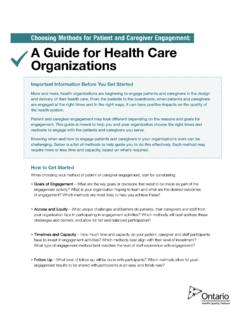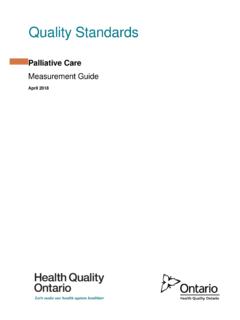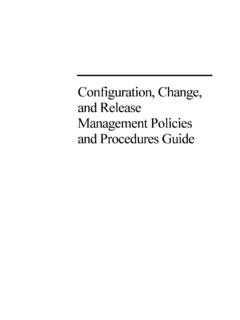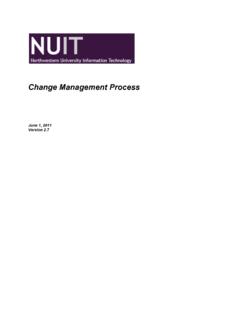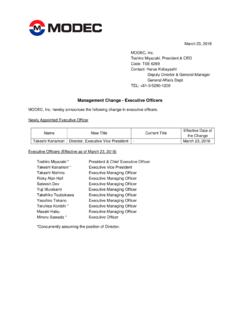Transcription of Quality Improvement Primers - HQOntario
1 change ManagementQuality Improvement PrimersACKNOWLEDGEMENTSThis workbook is the result of the efforts of the Health Quality Ontario (HQO) For additional information about other resources, contact: Health Quality Ontario may reproduce these materials for their use provided that proper attribution is given to the appropriate source. The recommended citation for this resource guide is: Health Quality Ontario (April 2013).HQO is funded by the Ontario Ministry of Health and Long-Term Care (MOHLTC). Queen s Printer for Ontario, 2013 change management | Health Quality Ontario 3 change management in Quality Improvement ..4 Additional Reading: ..4 Why think about change management ? ..4 System 1 (Emotional brain) ..5 System 2 (Rational brain) ..5 Incorporating the Two Minds into change Initiatives ..6 Try it yourself.
2 6 Switch Framework ..7 1. Motivating ..7 2. Directing ..7 3. Shaping the Path ..8 Applying the Ideas to Quality Improvement ..9 Table of Contents4 change management | Health Quality OntarioCHANGE management IN Quality IMPROVEMENTThis primer addresses the principles and practices of change management and its application to Quality Improvement . It is intended to be used as a guide for the design and implementation of successful change efforts, and to better understand how individuals, teams and organizations shift or change from a current state to a future state. This primer is based upon several theories of change management , primarily Chip and Dan Heath s SWITCH: How to change Things When change Is Hard. This work was chosen because it is applicable to any change initiative, big or small, health care or otherwise.
3 We recommend reading this text in its entirety as it contains many examples and cites interesting research that will be helpful in managing change processes. Additional Reading: 1. Haidt, J. (2006). The Happiness Hypothesis: Finding Modern Truth in Basic Wisdom. New York: Basic Kahneman, D. (2011). Thinking, Fast and Slow. New York: Farrar, Straus and Kotter, J. & Cohen, D. (2002) The Heart of change : Real-Life Stories of How People change Their Organizations. Boston: Harvard Business Press. WHY THINK ABOUT change management ? change can be challenging whether the change is for individuals, teams, organizations or societies. If you are involved in introducing a new way of doing something, you are managing a process of change , whether you realize it or not. It has been estimated that 70% of change initiatives fail1 because: change plans do not include those affected early enough in the planning change plans do not consider human factors, , motivations and human behaviours Individual barriers to change are not directly addressed Sustainability is not built in from the beginning.
4 Applying the principles of change management mitigates the above concerns and increases the likelihood of experiencing successful change . change management draws upon research in psychology and sociology to make change easier and more sustainable. Even altering the morning routine at home so everyone leaves the house one hour earlier than usual is a process change . For example, making lunches the night before instead of in the morning requires changes to routines. Now, due to the change in lunch making, preparing hot soup for lunch is no longer an option. This small change means that you need to alter your grocery list to reduce the amount of soup you buy and increase the amount of bread for sandwiches. change management | Health Quality Ontario 5A significant amount of research has been done to identify the steps necessary in an effective change process.
5 Authors Kotter and Cohen present an eight-step plan in their book The Heart of These change steps are summarized Create a burning platform, in other words, an extremely urgent or compelling business case to convey, in the strongest terms, the need for change2. Gather a guiding team/steering committee3. Have the team create a vision of the future and action plans4. Communicate upcoming changes5. Make change steps easy and clear6. Create ways for quick wins to be seen and felt by those affected7. Build on the quick wins, learn from the challenges and continue on8. Plan for sustainability In addition to following the change management steps outlined above, it is important to consider the psychology of the individuals making the changes. As we conduct our daily affairs and think about the large and small challenges we face, make decisions, act and reflect, we draw upon two different parts of our brains.
6 Psychological research has demonstrated that these two parts correspond to two distinct modes of thinking: an emotional mode and a rational/logical Kahneman, in his book Thinking, Fast and Slow,3 described and characterized these two thinking modes as follows: System 1 (Emotional brain)Quick, reactive and sometimes emotional brain. It functions on thinking shortcuts and continually generates suggestions for System 2 (Rational brain)Rational and reflective brain that deliberates and analyzes and responds to questions that System 1 can not answer. 6 change management | Health Quality OntarioINCORPORATING THE TWO MINDS INTO change INITIATIVESThis idea of two modes of thinking is important to successfully bring about change . Considering the human factors in each step of the change journey will help ensure that the change is successful.
7 Below is an illustration that links the idea of two minds in Kahneman s work to the change management theory outlined in Heath s text:System 1:System 2:This is the quick, reactive, sometimes emotional brain. It is automatic, initiated with no effort and very little control. Examples include perceptions, fears, innate skills, and skills that have become automatic through practice. It operates based on thinking shortcuts and continually generates suggestions for System 2. This is the rational and reflective brain that deliberates and analyzes and responds to questions that System 1 cannot answer. Examples include filling out a tax form, checking the validity of a complex logical argument, planning, and managing behaviour in social way to understand System 1 and System 2 thinking, expressed by Jonathan Haidt in The Happiness Hypothesis, is to imagine a person (the Rider) sitting on top of an elephant, trying to control the movement of the large and powerful animal so that it will go in a particular direction.
8 The Rider knows where he wants to go but is small and weak compared to the Elephant. He needs the cooperation of the Elephant to move forward. The ideal situation is for the Rider and Elephant to work Elephant System 1:is the emotional, automatic brain. It is very powerful and if motivated can be a powerful driver for change . If the Elephant is unmotivated, or worse, spooked by a proposed change , then success is less likely. is the logical, more deliberate brain. The Rider is a good planner and director of action but can become powerless when overwhelmed by the force of a motivated or unmotivated Elephant. The Rider System 2:Try it yourself Over the next few days, pay attention to these two types of thinking in your day-to-day activities. You may start to notice how much of your thinking is sourced (at least initially) from System 1 (emotional/elephant) and then further processed and shaped by System 2 (rational/rider).
9 change management | Health Quality Ontario 7 Switch FrameworkAccording to Chip and Dan Heath, authors of SWITCH, the three main components of the change management framework are Motivating, Directing and These components are explained in more detail below. 1. MotivatingSystem 1 (the elephant), is emotional, reactive and powerful. This component involves motivating the elephant so that you can use its power and force to compel action and sustain the momentum for change . It is also important to avoid scaring the elephant. When motivating the Elephant, try to follow the first two (and ideally all three) of the following recommendations: Find the feeling . Appeal directly to the emotions of your team (the Elephant, or System 1) make people feel something. Strive to make the need for change visual and visceral, use emotion (negative or positive), or use a pivotal testimonial.
10 This should compel people and motivate them to act. This is not about logic, it is about 1 (Emotional brain)System 2 Rational brain)Shrink the change . Break down the change until it no longer seems overwhelming. Identify an immediate goal that is easy to accomplish and provides the confidence and momentum to continue. This is about making the change feel small and imminently doable instead of scaring people away from making the change because it seems too your people . Cultivate a shared identity and common goals that will encourage all people to work toward the same Directing System 2, (the rider) is the planner and thinker. The rider can provide direction to the powerful (but willful) elephant (System 1). However, the rider has a tendency to over-think. To optimize the effectiveness of the rider, follow these recommendations: Point to the destination.

